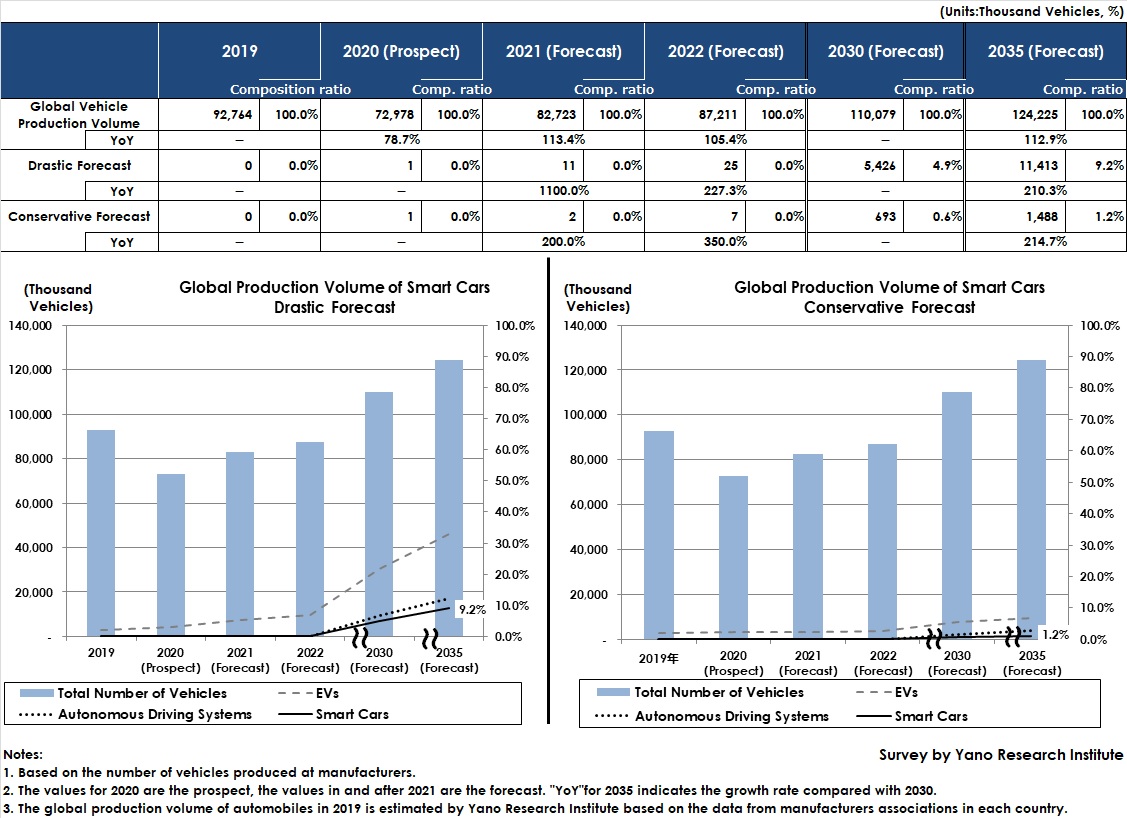No.2516
Global Smart Car Market: Key Research Findings 2020
Global Production Volume of Smart Cars (EVs with V2X and Level-4 Autonomous Driving) Reaches 11,410 Thousand by 2035 (Drastic Forecast)
Yano Research Institute (the President, Takashi Mizukoshi) carried out a survey on the global smart car market and found out the trend of related technologies, attempts at major automakers, and future outlook.

Market Overview
In 2016 Daimler announced CASE (Connected, Autonomous, Shared & Service, and Electric) as four trends that thoroughly change automobiles. Ever since then, the word has infiltrated in the industry as an indicator of electric vehicle development. However, in reality, after four years have passed since the announcement, the evolution has been slower than imagined. Although CASE is irreversible when considering enhanced environmental regulations and increased consumer demand, the conditions have become arduous, as the automobile sales decreasing and the development cost expanding in the economy seriously affected by COVID-19 pandemics.
This research considers a smart car as an indicator of evolvement of CASE, and forecasts the global production volume of smart cars which are regarded as electric vehicles equipped with V2X (vehicle-to-everything) communications and level-4 autonomous driving systems.
Noteworthy Topics
Smart Cars Boosted by MaaS
A smart car needs installation of diverse and expensive components such as cameras, various sensors including LiDAR, high-capacity lithium-ion batteries, and communication modules. When these are reflected into the vehicle price, the smart car for POV (Personally Owned Vehicle) must be a luxury one. Therefore, expansion of smart cars for POVs is limited. Rather, there is potential for growth in commercial MaaS-specific vehicles such as taxis, shared cars, buses, and minivans with specific purposes.
MaaS (Mobility as a Service) refers to an ecosystem that provides one stop solution for the combination of all kinds of transportation methods, power charging, and parking (which is called “the basic MaaS”) together with peripheral services including food and tourism at the destinations by which stimulating transportation demand (“Objective MaaS”), with all such services available through integrated payment. Because of its nature being connected and able to provide the services for intangible goods, smart cars are expected to take part in MaaS extensively.
Future Outlook
The smart car market comprises multiple factors intertwined, making it difficult to forecast a specific part of the whole market. For instance, V2X (vehicle to everything) communications had been considered to be delivered through DSRC (Dedicated Short Range Communication), but the recent rise of cellular V2X has gained considerable momentum, requiring additional investments for development as well as technological verifications for specification revisions and cyber security measures.
EVs are likely to be accepted to a certain degree, because of environmental regulations becoming stricter and of establishments of regulations for NEVs (New Energy Vehicles) and CAFE (Corporate Average Fuel Efficiency). On the other hand, however, the number of NEVs sold in China in the latter half of 2019 declined by 30% on a year-to-year basis due to decreased incentives for purchasing NEVs in 2019, which indicates NEVs are still the products that sell well only when financial aid is applied.
Based on the circumstances mentioned above and other trends in regulations together with the progress in experimental demonstrations of smart cars, this research provides two patterns of market size forecasts depending on the prevalence of EVs and level-4 autonomous driving systems as of 2035: The drastic forecast indicates the growth scenario of a single MaaS-specific vehicle to be replaced by three POVs (Personally Owned Vehicle,) while the conservative forecast is the growth scenario of a MaaS-specific vehicle to be replaced by two POVs.
The global production volume of smart cars for 2035 is expected to be 11,410 thousand (occupying 9.2% of the total vehicle production volume) by the drastic forecast, and 1,480 thousand (1.2% of the total vehicle production volume) by the conservative forecast.
Research Outline
2.Research Object: Domestic and international major automakers, suppliers of automotive parts, manufacturers of semiconductors and electronic parts, etc.
3.Research Methogology: Face-to-face interviews by the expert researchers, surveys via telephone, and literature research
What is a Smart Car?
A smart car in this research refers to an electric vehicle equipped with V2X (vehicle-to-everything) communications and level-4 autonomous driving systems, by which achieving CASE (Connected, Autonomous, Shared & Service, and Electric).
<Products and Services in the Market>
V2X (vehicle-to-everything) communications (DSRC, cellular) EV, EV charging infrastructure, level-4 autonomous driving systems
Published Report
Contact Us
The copyright and all other rights pertaining to this report belong to Yano Research Institute.
Please contact our PR team when quoting the report contents for the purpose other than media coverage.
Depending on the purpose of using our report, we may ask you to present your sentences for confirmation beforehand.